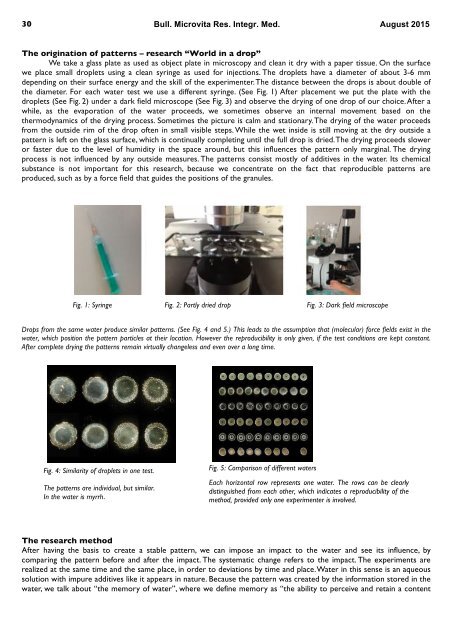B O M R I M
BOMRIM August 2015
BOMRIM August 2015
Create successful ePaper yourself
Turn your PDF publications into a flip-book with our unique Google optimized e-Paper software.
30<br />
Bull. Microvita Res. Integr. Med. August 2015<br />
The origination of patterns – research “World in a drop”<br />
We take a glass plate as used as object plate in microscopy and clean it dry with a paper tissue. On the surface<br />
we place small droplets using a clean syringe as used for injections. The droplets have a diameter of about 3-6 mm<br />
depending on their surface energy and the skill of the experimenter. The distance between the drops is about double of<br />
the diameter. For each water test we use a different syringe. (See Fig. 1) After placement we put the plate with the<br />
droplets (See Fig. 2) under a dark field microscope (See Fig. 3) and observe the drying of one drop of our choice. After a<br />
while, as the evaporation of the water proceeds, we sometimes observe an internal movement based on the<br />
thermodynamics of the drying process. Sometimes the picture is calm and stationary. The drying of the water proceeds<br />
from the outside rim of the drop often in small visible steps. While the wet inside is still moving at the dry outside a<br />
pattern is left on the glass surface, which is continually completing until the full drop is dried. The drying proceeds slower<br />
or faster due to the level of humidity in the space around, but this influences the pattern only marginal. The drying<br />
process is not influenced by any outside measures. The patterns consist mostly of additives in the water. Its chemical<br />
substance is not important for this research, because we concentrate on the fact that reproducible patterns are<br />
produced, such as by a force field that guides the positions of the granules.<br />
Fig. 1: Syringe Fig. 2: Partly dried drop Fig. 3: Dark field microscope<br />
Drops from the same water produce similar patterns. (See Fig. 4 and 5.) This leads to the assumption that (molecular) force fields exist in the<br />
water, which position the pattern particles at their location. However the reproducibility is only given, if the test conditions are kept constant.<br />
After complete drying the patterns remain virtually changeless and even over a long time.<br />
Fig. 4: Similarity of droplets in one test.<br />
The patterns are individual, but similar.<br />
In the water is myrrh.<br />
Fig. 5: Comparison of different waters<br />
Each horizontal row represents one water. The rows can be clearly<br />
distinguished from each other, which indicates a reproducibility of the<br />
method, provided only one experimenter is involved.<br />
The research method<br />
After having the basis to create a stable pattern, we can impose an impact to the water and see its influence, by<br />
comparing the pattern before and after the impact. The systematic change refers to the impact. The experiments are<br />
realized at the same time and the same place, in order to deviations by time and place. Water in this sense is an aqueous<br />
solution with impure additives like it appears in nature. Because the pattern was created by the information stored in the<br />
water, we talk about “the memory of water”, where we define memory as “the ability to perceive and retain a content


